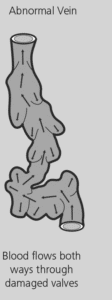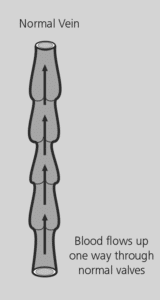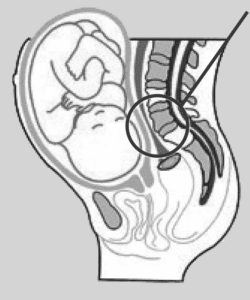Varicose Vein
The Importance of Blood Circulation
Blood circulation supplies the body with nutrients and oxygen and removes waste products. Together, the heart, arteries, and veins facilitate blood circulation. The heart pumps fresh, oxygen-rich blood throughout the body via the arteries. The veins channel oxygen-depleted blood back to the heart. Healthy veins are vital in maintaining good blood circulation in the body.
Veins and Valves
Valves inside the veins keep the blood moving back toward the heart. These valves prevent the force of gravity from pulling blood back down toward the feet.


Varicose Veins
When the veins are damaged, gravity will hinder normal blood flow causing
blood to form pools in the weakened, damaged veins. The pooling blood causes these veins to enlarge. Twisted masses of veins beneath the surface of the skin, known as varicose veins, often result. Varicose veins are larger and located deeper in the leg than spider veins. Spider veins are small red, blue and purple veins on the surface near the skin.
Effect of Pregnancy on the Venous System
During pregnancy, many hormonal changes occur in the body that has a profound effect on the veins. Blood volume increases between 40% to 50%, while increased amounts of progesterone cause the vein walls to dilate and become less elastic.

The pressure of the fetal head in the pelvis can compress the iliac veins and obstruct venous outflow from the legs. As the baby grows, the uterus enlarges and applies pressure on important veins that return blood to the heart. This pressure can cause a slowing of the blood flow and valve damage, resulting in swelling, leg discomfort, and even varicose veins. A pregnant woman’s feet and legs may start to swell after sitting or standing for only a short time. In principle, this is a completely normal symptom. However, if your feet are already swollen when you get up in the morning, consult your doctor. While these symptoms may subside after delivery, with each subsequent pregnancy, they are less likely to completely disappear.
Pregnancy and DVT
Women who are pregnant are at a high risk for the development of a Deep Vein Thrombosis, known as DVT. One reason is due to the increased blood volume at full term.
Additionally, pregnancy causes hormonal changes that increase blood coagulability, a measure of how easily blood clots. The expanding uterus puts pressure on blood vessels, restricting blood flow from the legs and pelvis back to the heart.
Slower blood flow increases the risk of Deep Vein Thrombosis. The risk continues during the postpartum period until the woman’s hormonal levels return to their pre-pregnancy state.
Common Leg Health Problems During Pregnancy
Venous disorders and leg health problems are among the most frequent medical conditions in North America. You may experience these conditions for the first time during pregnancy. For example, swollen feet, tired aching legs and a feeling of heaviness in the legs are among everyday symptoms that pregnant women may experience.
These symptoms are especially frequent when:
• a history of varicose veins and venous disease exists in the family
• a venous condition was already present before the pregnancy
• the woman sits and stands for prolonged periods of time while pregnant
• the woman does not exercise regularly during the pregnancy, or
• the woman has had more than one pregnancy
Pregnancy plays a role in the development of varicose veins. 30% of women pregnant for the first time, and 55% of women who have had two or more full-term pregnancies develop varicose veins.

